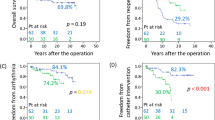Abstract
Protein-losing enteropathy (PLE) is a life-threatening complication in patients following the Fontan operation. However, PLE also develops in some patients with congenital heart disease (CHD) after biventricular repair (BVR). This study compared clinical profiles of PLE patients following the Fontan operation with those after BVR. We retrospectively reviewed clinical charts of postoperative CHD patients with PLE. The study population comprised 42 PLE patients (14BVR, 28Fontan). Postoperative follow-up period until onset was significantly shorter in the Fontan group than in the BVR group (14 ± 2 vs. 8 ± 1 years, p = 0.02), while there was no difference in PLE onset age between groups. Furthermore, there were no differences in prevalence of clinically relevant arrhythmias, cardiac output, or central venous pressure between the two groups at PLE onset. Percentage of structural lesions (valve regurgitation and/or stenotic lesions) responsible for development of PLE and ventricular end-diastolic pressure were higher in the BVR group than in the Fontan group (93 vs. 50%, p < 0.01), (13.4 ± 6.3 vs. 7.5 ± 4.1, p < 0.0001). Catheter intervention was applied in 2Fontan and 6BVR patients, while surgical intervention was required in 8BVR and 7Fontan patients. Of these, catheter intervention was effective in 2 (25%, 1Fontan, 1BVR) and surgical intervention was effective in 4 (26.7%, 1Fontan, 3BVR). Only one patient (5.3%) improved without intervention. Complete PLE remission rate was higher in the BVR group than in the Fontan group (38 vs. 7%, p = 0.02). During follow-up, death of 2 BVR and 8 Fontan patients occurred. There were no group differences in 5- to 10-year survival rates after PLE onset (81 vs. 81%, BVR, 81 vs. 66%, Fontan). Although BVR patients may have greater chance of PLE remission when compared with those exhibiting Fontan pathophysiology, mortality in PLE-CHD patients was significantly high regardless of postoperative hemodynamics.

Similar content being viewed by others
References
John AS et al (2014) Clinical outcomes and improved survival in patients with protein-losing enteropathy after the Fontan operation. J Am Coll Cardiol 64(1):54–62
Feldt RH et al (1996) Protein-losing enteropathy after the Fontan operation. J Thorac Cardiovasc Surg 112(3):672–680
Mertens L et al (1998) Protein-losing enteropathy after the Fontan operation: an international multicenter study. PLE study group. J Thorac Cardiovasc Surg 115(5):1063–1073
Davidson JD et al (1961) Protein-losing gastroenteropathy in congestive heart-failure. Lancet 1(7183):899–902
Wilkinson P, Pinto B, Senior JR (1965) Reversible protein-losing enteropathy with intestinal lymphangiectasia secondary to chronic constrictive pericarditis. N Engl J Med 273(22):1178–1181
Zoghbi WA et al (2003) Recommendations for evaluation of the severity of native valvular regurgitation with two-dimensional and Doppler echocardiography. J Am Soc Echocardiogr 16(7):777–802
Feltes TF et al (2011) Indications for cardiac catheterization and intervention in pediatric cardiac disease: a scientific statement from the American Heart Association. Circulation 123(22):2607–2652
Bonow RO et al (2006) ACC/AHA 2006 guidelines for the management of patients with valvular heart disease: a report of the American College of Cardiology/American Heart Association Task Force on Practice Guidelines (writing committee to revise the 1998 Guidelines for the Management of Patients With Valvular Heart Disease): developed in collaboration with the Society of Cardiovascular Anesthesiologists: endorsed by the Society for Cardiovascular Angiography and Interventions and the Society of Thoracic Surgeons. Circulation 114(5):e84–e231
Muller C et al (1991) Constrictive pericarditis without typical haemodynamic changes as a cause of oedema formation due to protein-losing enteropathy. Eur Heart J 12(10):1140–1143
Ohuchi H et al (2013) Haemodynamic characteristics before and after the onset of protein losing enteropathy in patients after the Fontan operation. Eur J Cardiothorac Surg 43(3):e49-57
Ohuchi H et al (2016) Heart failure with preserved right ventricular ejection fraction in postoperative adults with congenital heart disease: a subtype of severe right ventricular pathophysiology. Int J Cardiol 212:223–231
Mizuno M et al (2013) Experience of decortication for restrictive hemodynamics in adults with congenital heart disease. Pediatr Int 56(4):630–633
Author information
Authors and Affiliations
Corresponding author
Ethics declarations
Conflict of interest
The authors have no competing interests to disclose. All authors have approved the final version of the manuscript.
Ethical Approval
The National Cerebral and Cardiovascular Center Institutional Review Board approved this retrospective study.
Informed Consent
Informed consent was obtained from all patients and/or their parents.
Rights and permissions
About this article
Cite this article
Ono, S., Ohuchi, H., Miyazaki, A. et al. Comparison of Clinical Profiles in Patients with Protein-Losing Enteropathy With and Without Fontan Circulation. Pediatr Cardiol 39, 1290–1298 (2018). https://doi.org/10.1007/s00246-018-1893-9
Received:
Accepted:
Published:
Issue Date:
DOI: https://doi.org/10.1007/s00246-018-1893-9



